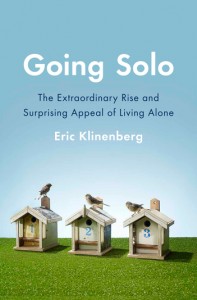Introducing "AI: Adventures in Ideas," a New Blog Series from Sudhir Venkatesh. Episode 1: Going Solo
This is the first installment of a new Freakonomics.com feature from Sudhir Venkatesh. Each AI: Adventures in Ideas post will showcase new research, writing, or ideas.
 A new book is garnering significant attention. In Going Solo
A new book is garnering significant attention. In Going Solo, Eric Klinenberg, a sociologist at NYU, looks at a growing trend in contemporary adulthood: living alone. How we live, Klinenberg argues, is shifting, and it could be one of the most important developments of the last half-century. You may have seen the book discussed in a recent David Brooks column, in addition to other places (The New York Times, Slate, the Wall Street Journal), and Klinenberg even produced a hot soundtrack for Rolling Stone of the songs that accompany the “Going Solo” lifestyle.
Klinenberg agreed to answer a few of my questions for Freakonomics readers:

Q.Where did the idea for this book come from? Does it connect with your earlier work, especially Heat Wave?
A.The idea came straight out of Heat Wave, in which I argued that hundreds died alone in the 1995 Chicago disaster because an unprecedented number of people were living alone in Chicago every day. In that book, I focused on the most vulnerable and isolated singletons (my term for people who live alone): the elderly, the poor, and the sick. During that project, I thought of living alone as a dangerous condition, perhaps even a tragic one. But when I pulled back and looked at the bigger picture, I realized these groups were a small fraction of the singleton population and that they were hardly unique to Chicago. I also discovered something that startled me: Until the 1950s, there was not a single society in human history that sustained large numbers of people living alone. Today, however, going solo is common wherever people can afford to do it and particularly in cities. That fact raised a difficult but fascinating research question: Of all the ways that individuals in the world’s most affluent societies could use their resources, why are they using them to live alone?
Q.This book challenges some widely held views. You paint a far rosier picture of “living alone” than most readers would expect. Who has an interest in offering a more negative portrayal? Are there political implications? Are established religions going to be upset, alleging that you favor “living in sin”? Perhaps there are established social scientific dogmas that might need re-tooling based on your work
A.It does challenge some widely held views, including some that I held before doing this research. For instance: People generally think that singletons are disconnected and self-centered; in fact, they are more likely than married people to spend time with friends and neighbors, more likely to attend lectures and art classes, and even more likely to volunteer. Pundits and professors often say that the rise of living alone has ushered in an epidemic of loneliness and social isolation, but there’s little evidence that levels of loneliness have increased dramatically in recent decades. Moreover, that scary, widely-discussed study from 2006 reporting an unbelievable spike in social isolation, resulting in one in four Americans having no confidants? Turns out it was based on unreliable data, and recently one of the authors told the Chronicle of Higher Education that it’s “unreliable.”
Going Solo also upends the conventional view that our increasing personal autonomy results in declining communities, fraying social ties, and diminished social capital. There’s a long tradition of sociology books – great ones, even – that lament the loss of a Golden Age of togetherness and portray the contemporary world as a lonely, atomized place. I don’t subscribe to this view. During this project, I came to appreciate how creatively we are adapting to our unprecedented experiment in solo living and to understand how socially engaged most singletons have become. I’m not glib about it since the heat wave showed me the horrors of isolation. But if we only look at the social problems, we’ll miss the most interesting changes that this new way of living makes possible.
Some articles about the book key into the sections that illustrate the pleasures of going solo, and they argue that I paint a rosy picture of living alone. But others focus on the sections that address the challenges of being lonely or – in a story I originally reported for This American Life – even dying alone. These stories characterize the book as dark and haunting, a completely different take! I’ve come to believe that the topic of living alone is something like a Rorscharch test: our reaction to it says as much about us as it does about the condition.
Thus far, the only groups to insist that living alone is bad for individuals and society are conservative Christian organizations whose political agenda involves promoting marriage and rolling back women’s right to choose. Here’s one complaint, published online by the Gospel Coalition: “Apart from Klinenberg’s data that people want this level of independence, it’s hard to imagine that this autonomy, which allows for people ‘to engage with other when and how we want to and on our terms,’ would be good for any society. This hardly encourages acts of kindness and hospitality, something one would assume a ‘flourishing’ society needs. Even more, for those of us who believe the Bible and want to see the gospel influence culture, this lone-ranger mentality would mean death.”
This is an ideological attack, not a scientific one, and it’s interesting that it begins by dismissing the fact that people want to live this way. I replied by sending them the evidence that singletons, and women in particular, are more likely to volunteer in civic groups than married people who are busy with domestic responsibilities. But I don’t think there’s much chance of a productive debate.
Q.In the conclusion of your book, you write that living alone is “an individual choice.” Most sociologists tend to downplay the freedom to choose, as it were. Why do you feel that it is so important to emphasize “choice”? Are you trying to get economists to buy this book?
A. Ah, you noticed! And of course I want economists to buy the book. After all, they make much more money than the rest of us social scientists, so they probably have more di
sposable income for books, too!
When I present this work to sociologists, I actually use a slide that says: “Wait! Did a sociologist just say: ‘Choice?’” And it usually provokes an uncomfortable laugh. The reason is that we’ve developed a bizarre and unproductive division of intellectual labor: Economists study choice, and sociologist study constraint! There’s no justification for this in either field.
As a sociologist, I always emphasize that none of us get to choose the choices we have to choose from. But people who live alone almost always have other options and less expensive ones, too! Anyone can move in with roommates. (Craigslist offers an entire universe of domestic companions.) Most people have friends or family with whom they could shack up, too. A century ago, the great majority of widows and widowers moved in with their children. Today, most old people who outlive their spouse do everything possible to maintain a place of their own. Fifty years ago, only 1 percent of young adults under 30 lived alone. Today, even in this terrible job market, 11 percent do, and they stretch their budgets to attain the benefits of going solo. How can we explain this without the concept of choice?
Q.From a data standpoint, can you give us a few facts and figures that surprised you about living alone?
A.First, it’s surprisingly common. In 1950, only 4 million Americans lived alone, and they accounted for 9 percent of all households. Back then, living alone was most prevalent in open, sprawling Northwestern states, such as Alaska, Wyoming, Montana. And the typical singleton was a man, likely on his way to a more conventional marriage.
Today, 32.7 million Americans are singletons; they represent 28 percent of all households; and they are primarily women (especially over the age of 45). Now, solo livers congregate in cities and in all parts of the country. Atlanta, Denver, Minneapolis, San Francisco, and Seattle are among the many cities where more than 40 percent of all households have just one resident. In Wahington D.C. and Manhattan, it’s closer to 50 percent.
Second, it’s not an American phenomenon, which means it’s not rooted in some unique cultural attachment to individualism and self-reliance. (Sorry, Mr. Thoreau!) Living alone is actually most common in the more socialist-leaning Scandinavian nations, where the government’s social programs and housing projects give people the security they need to go solo. It’s more prevalent in England, Germany, France, Canada, and Japan than it is in the United States. And it’s growing most rapidly in nations with the fastest growing economies, such as India, China, and Brazil.
Q.There’s a lot of interesting discussion about the intersection of lifestyle and politics. What are some of the implications of the book for the upcoming presidential election? Specifically, do you think any of the candidates has really understood the implications of this new trend?
A.This year, there are more than 100 million unmarried American adults, nearly a third of whom live alone. Single women tend to support reproductive rights, access to health care, gun control, and funding for public schools, so they usually vote for Democrats. Historically, however, single women have had low turnout levels, and in recent years, the Democratic Party has been trying to mobilize them. Some prominent pollsters, including Stanley Greenberg, argue that single women gave Obama a decisive edge in the 2008 election. But in 2010, the number of single, white women who voted for Republicans rose dramatically (to 50 percent, from 39 percent in 2008), and unless the economy continues to improve, they may still be receptive to Republicans who court them.
Republicans risk alienating singles and singletons if they resurrect the “family values” theme in the 2012 campaign. That phrase implicitly casts judgment on roughly half the adult population, and they may not turn out for a candidate whose campaign insults them. Then again, this year, voters will likely choose whichever candidate seems most likely to revive the economy and generate more jobs. Remember, living alone is a luxury and an expensive one, too!

Comments